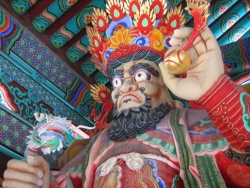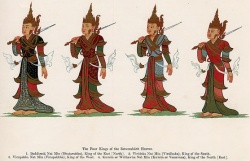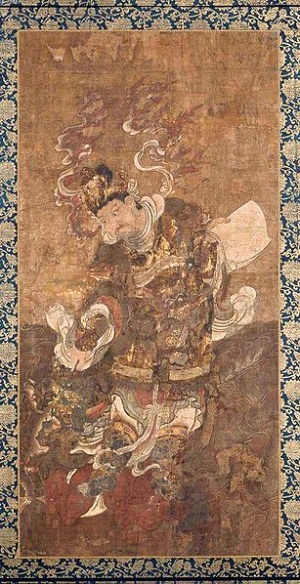Difference between revisions of "Four Heavenly Kings"
m (Text replacement - "the Dharma" to "the Dharma") |
|||
| Line 2: | Line 2: | ||
In the [[Buddhist]] [[faith]], the [[Four Heavenly Kings]] are four [[gods]], each of whom watches over one [[cardinal direction]] of the [[world]]. In {{Wiki|Chinese}} they are known collectively as the "Fēng Tiáo Yǔ Shùn" (風調雨順 / 风调雨顺? lit. "Good Climate"). | In the [[Buddhist]] [[faith]], the [[Four Heavenly Kings]] are four [[gods]], each of whom watches over one [[cardinal direction]] of the [[world]]. In {{Wiki|Chinese}} they are known collectively as the "Fēng Tiáo Yǔ Shùn" (風調雨順 / 风调雨顺? lit. "Good Climate"). | ||
[[File:Four Guardian.jpg|thumb|250px|The Four Guardian Kings in Burmese depiction.]] | [[File:Four Guardian.jpg|thumb|250px|The Four Guardian Kings in Burmese depiction.]] | ||
| − | ==Nomenclature== | + | =={{Wiki|Nomenclature}}== |
The [[Kings]] are collectively named as follows. | The [[Kings]] are collectively named as follows. | ||
{| class="wikitable" | {| class="wikitable" | ||
| Line 16: | Line 16: | ||
|[[Four Great Kings]] | |[[Four Great Kings]] | ||
|- | |- | ||
| − | |Lokapāla | + | |[[Lokapāla]] |
|[[Guardians of the world]] | |[[Guardians of the world]] | ||
|- | |- | ||
| − | |Sinhala | + | |[[Sinhala]] |
|සතරවරම් දෙවිවරු | |සතරවරම් දෙවිවරු | ||
|Satharawaram Dewi | |Satharawaram Dewi | ||
| Line 27: | Line 27: | ||
|စတုလောကပါလ<br/>စတုမဟာရာဇ်နတ် | |စတုလောကပါလ<br/>စတုမဟာရာဇ်နတ် | ||
|sətṵ lɔ́ka̰ pàla̰<br/>sətṵ məhà ɹɪʔ naʔ | |sətṵ lɔ́ka̰ pàla̰<br/>sətṵ məhà ɹɪʔ naʔ | ||
| − | | Four [[worldly]] guardians<br/>Four Great [[King]] Nats | + | | Four [[worldly]] {{Wiki|guardians}}<br/>Four [[Great]] [[King]] Nats |
|- | |- | ||
|rowspan=3|Chinese | |rowspan=3|Chinese | ||
| Line 62: | Line 62: | ||
|[[Vietnamese]] | |[[Vietnamese]] | ||
| 四天王 | | 四天王 | ||
| − | |Tứ Thiên Vương | + | |Tứ [[Thiên]] Vương |
| Four [[heavenly kings]] | | Four [[heavenly kings]] | ||
|- | |- | ||
|[[Tibetan]] | |[[Tibetan]] | ||
| − | |རྒྱལ༌ཆེན༌བཞི༌ | + | |{{BigTibetan|རྒྱལ༌ཆེན༌བཞི༌}} |
|[[rgyal chen bzhi]] | |[[rgyal chen bzhi]] | ||
| Four great {{Wiki|kings}} | | Four great {{Wiki|kings}} | ||
| Line 73: | Line 73: | ||
|Махаранз | |Махаранз | ||
|[[maharanja]] | |[[maharanja]] | ||
| − | | (Four) Great {{Wiki|kings}} | + | | (Four) [[Great]] {{Wiki|kings}} |
|- | |- | ||
|rowspan=2|Thai | |rowspan=2|Thai | ||
| Line 85: | Line 85: | ||
|} | |} | ||
| − | ==The Four [[Heavenly]] Kings== | + | ==The Four [[Heavenly]] [[Kings]]== |
| − | The [[Four Heavenly Kings]] are said to currently [[live]] in the Cāturmahārājika [[heaven]] ([[Pāli]] [[Cātummahārājika]], "Of the [[Four Great Kings]]") on the lower slopes of [[Mount Sumeru]], which is the lowest of the six [[worlds]] of the [[devas]] of the [[Kāmadhātu]]. They are the [[protectors]] of the [[world]] and fighters of [[evil]], each able to command a legion of [[supernatural]] creatures to protect the [[Dharma]]. | + | The [[Four Heavenly Kings]] are said to currently [[live]] in the Cāturmahārājika [[heaven]] ([[Pāli]] [[Cātummahārājika]], "Of the [[Four Great Kings]]") on the lower slopes of [[Mount Sumeru]], which is the lowest of the six [[worlds]] of the [[devas]] of the [[Kāmadhātu]]. They are the [[protectors]] of the [[world]] and fighters of [[evil]], each able to command a legion of [[supernatural]] creatures to {{Wiki|protect}} the [[Dharma]]. |
{| class="wikitable" | {| class="wikitable" | ||
|- | |- | ||
| − | |devanagari<br>[[Sanskrit]] romanization | + | |{{Wiki|devanagari}}<br>[[Sanskrit]] romanization |
| |वैश्रवण (कुबेर)<br>[[Vaiśravaṇa]] ([[Kubera]]) | | |वैश्रवण (कुबेर)<br>[[Vaiśravaṇa]] ([[Kubera]]) | ||
| विरूढक<br>[[Virūḍhaka]] | | विरूढक<br>[[Virūḍhaka]] | ||
| Line 102: | Line 102: | ||
|he who sees all | |he who sees all | ||
|- | |- | ||
| − | |devanagari<br>[[Pāli]] romanization | + | |{{Wiki|devanagari}}<br>[[Pāli]] romanization |
|वेस्सवण (कुवेर)<br>Vessavaṇa ([[Kuvera]]) | |वेस्सवण (कुवेर)<br>Vessavaṇa ([[Kuvera]]) | ||
|विरूळ्हक<br>[[Virūḷhaka]] | |विरूळ्हक<br>[[Virūḷhaka]] | ||
| Line 108: | Line 108: | ||
|विरूपक्ख<br>[[Virūpakkha]] | |विरूपक्ख<br>[[Virūpakkha]] | ||
|- | |- | ||
| − | |Sinhala<br>romanization | + | |[[Sinhala]]<br>romanization |
|වෛශ්රවණ<br>Vessavaṇa | |වෛශ්රවණ<br>Vessavaṇa | ||
|විරෑඪ<br>[[Virūḷhaka]] | |විරෑඪ<br>[[Virūḷhaka]] | ||
| Line 154: | Line 154: | ||
|- | |- | ||
|Sino-Vietnamese | |Sino-Vietnamese | ||
| − | |Đa Văn Thiên | + | |Đa Văn [[Thiên]] |
| − | |Tăng Trưởng Thiên | + | |Tăng Trưởng [[Thiên]] |
| − | |Trì Quốc Thiên | + | |Trì Quốc [[Thiên]] |
| − | |Quảng Mộc Thiên | + | |Quảng Mộc [[Thiên]] |
|- | |- | ||
|[[Tibetan]] romanization | |[[Tibetan]] romanization | ||
| Line 165: | Line 165: | ||
|spyan.mi.bzang (Chenmizang) | |spyan.mi.bzang (Chenmizang) | ||
|- | |- | ||
| − | |Color | + | |{{Wiki|Color}} |
|yellow | |yellow | ||
|red | |red | ||
| Line 181: | Line 181: | ||
|- | |- | ||
|[[stupa]] | |[[stupa]] | ||
| − | |pearl | + | |{{Wiki|pearl}} |
|- | |- | ||
|Followers | |Followers | ||
| Line 190: | Line 190: | ||
|- | |- | ||
|[[Direction]] | |[[Direction]] | ||
| − | |north | + | |{{Wiki|north}} |
| − | |south | + | |{{Wiki|south}} |
| − | |east | + | |{{Wiki|east}} |
| − | |west | + | |{{Wiki|west}} |
|} | |} | ||
| − | All four serve [[Śakra]], the [[lord]] of the [[devas]] of [[Trāyastriṃśa]]. On the 8th, 14th and 15th days of each lunar month, the [[Four Heavenly Kings]] either send out messengers or go themselves to see how [[virtue]] and [[morality]] are faring in the [[world]] of men. Then they report upon the state of affairs to the assembly of the [[Trāyastriṃśa]] [[devas]]. | + | All four serve [[Śakra]], the [[lord]] of the [[devas]] of [[Trāyastriṃśa]]. On the 8th, 14th and 15th days of each [[lunar month]], the [[Four Heavenly Kings]] either send out [[messengers]] or go themselves to see how [[virtue]] and [[morality]] are faring in the [[world]] of men. Then they report upon the state of affairs to the assembly of the [[Trāyastriṃśa]] [[devas]]. |
| − | On the orders of [[Śakra]], the [[four kings]] and their retinues stand guard to protect [[Trāyastriṃśa]] from another attack by the [[Asuras]], which once threatened to destroy the kingdom of the [[devas]]. They are also vowed to protect the [[Buddha]], the [[Dharma]], and the [[Buddha's]] followers from [[danger]]. | + | On the orders of [[Śakra]], the [[four kings]] and their {{Wiki|retinues}} stand {{Wiki|guard}} to {{Wiki|protect}} [[Trāyastriṃśa]] from another attack by the [[Asuras]], which once threatened to destroy the {{Wiki|kingdom}} of the [[devas]]. They are also vowed to {{Wiki|protect}} the [[Buddha]], the [[Dharma]], and the [[Buddha's]] followers from [[danger]]. |
[[File:Fourheavenlykings.jpg|center|thumb|1000px|Statues of the Four Heavenly Kings. From left to right: Vaiśravaṇa, Virūḍhaka, Dhṛtarāṣṭra, and Virūpākṣa.]] | [[File:Fourheavenlykings.jpg|center|thumb|1000px|Statues of the Four Heavenly Kings. From left to right: Vaiśravaṇa, Virūḍhaka, Dhṛtarāṣṭra, and Virūpākṣa.]] | ||
| − | According to [[Vasubandhu]], [[devas]] born in the Cāturmahārājika [[heaven]] are 1/4 of a krośa in height (about 750 feet tall). They also have a five-hundred year lifespan, of which each day is equivalent to 50 years in our [[world]]; thus their total lifespan amounts to about nine million years (other sources say 90,000 years). | + | According to [[Vasubandhu]], [[devas]] born in the Cāturmahārājika [[heaven]] are 1/4 of a [[krośa]] in height (about 750 feet tall). They also have a five-hundred year lifespan, of which each day is equivalent to 50 years in our [[world]]; thus their total lifespan amounts to about nine million years (other sources say 90,000 years). |
[[File:Chomyo_Komokuten.jpg|thumb|right|Painting of Kōmokuten (Virūpākṣa), the Guardian of the West (one of the Four Guardian Kings). 13th century.]] | [[File:Chomyo_Komokuten.jpg|thumb|right|Painting of Kōmokuten (Virūpākṣa), the Guardian of the West (one of the Four Guardian Kings). 13th century.]] | ||
| − | The [[symbols]] that the [[Kings]] carry also link the [[deities]] to their followers; for instance, the [[nāgas]], [[magical]] creatures who can [[change]] [[form]] between [[human]] and [[serpent]], are led by [[Virūpākṣa]], represented by a [[snake]]; the [[gandharvas]] are [[celestial]] musicians, led by [[Dhṛtarāṣṭra]], represented with a lute. The umbrella was a [[symbol]] of regal sovereignty in {{Wiki|ancient India}}, and the sword is a [[symbol]] of martial prowess. Vaiśravaṇa's mongoose, which ejects jewels from its mouth, is said to represent [[generosity]] in opposition to [[greed]]. | + | The [[symbols]] that the [[Kings]] carry also link the [[deities]] to their followers; for instance, the [[nāgas]], [[magical]] creatures who can [[change]] [[form]] between [[human]] and [[serpent]], are led by [[Virūpākṣa]], represented by a [[snake]]; the [[gandharvas]] are [[celestial]] musicians, led by [[Dhṛtarāṣṭra]], represented with a lute. The umbrella was a [[symbol]] of regal sovereignty in {{Wiki|ancient India}}, and the sword is a [[symbol]] of {{Wiki|martial}} prowess. Vaiśravaṇa's mongoose, which ejects jewels from its {{Wiki|mouth}}, is said to represent [[generosity]] in opposition to [[greed]]. |
{|border="0" cellspacing="5" | {|border="0" cellspacing="5" | ||
| | | | ||
|align = "center"|[[Vaisravana|Tamon-ten]] | |align = "center"|[[Vaisravana|Tamon-ten]] | ||
| − | (north) | + | ({{Wiki|north}}) |
| | | | ||
|- | |- | ||
|align = "center"|[[Virūpākṣa|Kōmoku-ten]] | |align = "center"|[[Virūpākṣa|Kōmoku-ten]] | ||
| − | (west) | + | ({{Wiki|west}}) |
|align = "center"|'''Heavenly [[Kings]]'''<br>({{Wiki|Japanese}}) | |align = "center"|'''Heavenly [[Kings]]'''<br>({{Wiki|Japanese}}) | ||
|align = "center"|[[Dhṛtarāṣṭra|Jikoku-ten]] | |align = "center"|[[Dhṛtarāṣṭra|Jikoku-ten]] | ||
| − | (east) | + | ({{Wiki|east}}) |
|- | |- | ||
| | | | ||
|align = "center"|[[Virūḍhaka|Zōjō-ten]] | |align = "center"|[[Virūḍhaka|Zōjō-ten]] | ||
| − | (south) | + | ({{Wiki|south}}) |
| | | | ||
|} | |} | ||
| Line 226: | Line 226: | ||
<gallery caption="Statues of the Four Heavenly Kings of Jikō-ji, Takasago, Hyōgo, Japan. | <gallery caption="Statues of the Four Heavenly Kings of Jikō-ji, Takasago, Hyōgo, Japan. | ||
" perrow="4"> | " perrow="4"> | ||
| − | Image:Jikoji jikokuten.JPG|Jikoku-ten (east) | + | Image:Jikoji jikokuten.JPG|Jikoku-ten ({{Wiki|east}}) |
| − | Image:Jikoji zochoten.JPG|Zōjō-ten (south) | + | Image:Jikoji zochoten.JPG|Zōjō-ten ({{Wiki|south}}) |
| − | Image:Jikoji komokuten.JPG|Kōmoku-ten (west) | + | Image:Jikoji komokuten.JPG|Kōmoku-ten ({{Wiki|west}}) |
| − | Image:Jikoji tamonten.JPG|Tamon-ten (north) | + | Image:Jikoji tamonten.JPG|Tamon-ten ({{Wiki|north}}) |
</gallery> | </gallery> | ||
Revision as of 14:50, 17 September 2013
In the Buddhist faith, the Four Heavenly Kings are four gods, each of whom watches over one cardinal direction of the world. In Chinese they are known collectively as the "Fēng Tiáo Yǔ Shùn" (風調雨順 / 风调雨顺? lit. "Good Climate").
Nomenclature
The Kings are collectively named as follows.
| Language | Written form | Romanization | Translation |
|---|---|---|---|
| Sanskrit | चतुर्महाराज | caturmahārāja | Four Great Kings |
| Lokapāla | Guardians of the world | ||
| Sinhala | සතරවරම් දෙවිවරු | Satharawaram Dewi | Four Privileged/Bestowed Gods |
| Burmese | စတုလောကပါလ စတုမဟာရာဇ်နတ် |
sətṵ lɔ́ka̰ pàla̰ sətṵ məhà ɹɪʔ naʔ |
Four worldly guardians Four Great King Nats |
| Chinese | 天王 | Tiānwáng | Heavenly kings |
| 四天王 | Sì Tiānwáng | Four heavenly kings | |
| 四大天王 | Sì Da Tiānwáng | Four great heavenly kings | |
| Korean | 천왕 | Cheonwang | Heavenly kings |
| 사천왕 | Sacheonwang | Four heavenly kings | |
| 사대천왕 | Sadae Cheonwang | Four great heavenly kings | |
| Japanese | 四天王 | Shitennō | Four heavenly kings |
| Vietnamese | 四天王 | Tứ Thiên Vương | Four heavenly kings |
| Tibetan | རྒྱལ༌ཆེན༌བཞི༌ | rgyal chen bzhi | Four great kings |
| Mongolian | Махаранз | maharanja | (Four) Great kings |
| Thai | จาตุมหาราชา | chatumaharaja | Four great kings |
| จาตุโลกบาล | chatulokkaban | Four Guardians of the world |
The Four Heavenly Kings
The Four Heavenly Kings are said to currently live in the Cāturmahārājika heaven (Pāli Cātummahārājika, "Of the Four Great Kings") on the lower slopes of Mount Sumeru, which is the lowest of the six worlds of the devas of the Kāmadhātu. They are the protectors of the world and fighters of evil, each able to command a legion of supernatural creatures to protect the Dharma.
| devanagari Sanskrit romanization |
वैश्रवण (कुबेर) Vaiśravaṇa (Kubera) |
विरूढक Virūḍhaka |
धृतराष्ट्र Dhṛtarāṣṭra |
विरूपाक्ष Virūpākṣa |
| Meaning | he who hears everything | he who causes to grow | he who upholds the realm | he who sees all |
| devanagari Pāli romanization |
वेस्सवण (कुवेर) Vessavaṇa (Kuvera) |
विरूळ्हक Virūḷhaka |
धतरट्ठ Dhataraṭṭha |
विरूपक्ख Virūpakkha |
| Sinhala romanization |
වෛශ්රවණ Vessavaṇa |
විරෑඪ Virūḷhaka |
දෘතරාෂ්ට Dhataraṭṭha |
විරූපාක්ශ Virūpakkha |
| Thai romanization |
ท้าวกุเวร Thao Kuwen |
ท้าววิรุฬหก Thao Virunhok |
ท้าวธตรัฐ Thao Thatarot |
ท้าววิรูปักษ์ Thao Virupak |
| เวสวัณ,เวสสุวัณ,เวสสุวรรณ Vessavan | ||||
| Burmese | ကုဝေရ | ဝိရဠက | ဓတရဌ | ဝိရုပက္ခ |
| Traditional/Simplified Chinese Hanyu Pinyin |
多聞天王 / 多闻天王 Duō Wén Tiānwáng |
增長天王 / 增长天王 Zēng Zhǎng Tiānwáng |
持國天王 / 持国天王 Chí Guó Tiānwáng |
廣目天王 / 广目天王 Guăng Mù Tiānwáng |
| 毗沙門天 / 毗沙门天 | 留博叉天 / 留博叉天 | 多羅吒天 / 多罗吒天 | 毗琉璃天 / 毗琉璃天 | |
| kanji Hepburn romanization |
多聞天 (毘沙門天) Tamon-ten (Bishamon-ten) |
増長天 Zōjō-ten |
持国天 Jikoku-ten |
広目天 Kōmoku-ten |
| 治国天 Zōchō-ten | ||||
| romanized Korean | 다문천왕 Damun-cheonwang |
증장천왕 Jeungjang-cheonwang |
지국천왕 Jiguk-cheonwang |
광목천왕 Gwangmok-cheonwang |
| Sino-Vietnamese | Đa Văn Thiên | Tăng Trưởng Thiên | Trì Quốc Thiên | Quảng Mộc Thiên |
| Tibetan romanization | rnam.thos.sras (Namthöse) | phags.skyes.po (Phakyepo) | 'yul.'khor.srung (Yülkhorsung) | spyan.mi.bzang (Chenmizang) |
| Color | yellow | red | green | white |
| Symbol | umbrella | sword | pipa | serpent |
| mongoose | stupa | |||
| stupa | pearl | |||
| Followers | yakṣas | kumbhāṇḍas | gandharvas | nāgas |
| Direction | north | south | east | west |
All four serve Śakra, the lord of the devas of Trāyastriṃśa. On the 8th, 14th and 15th days of each lunar month, the Four Heavenly Kings either send out messengers or go themselves to see how virtue and morality are faring in the world of men. Then they report upon the state of affairs to the assembly of the Trāyastriṃśa devas.
On the orders of Śakra, the four kings and their retinues stand guard to protect Trāyastriṃśa from another attack by the Asuras, which once threatened to destroy the kingdom of the devas. They are also vowed to protect the Buddha, the Dharma, and the Buddha's followers from danger.
According to Vasubandhu, devas born in the Cāturmahārājika heaven are 1/4 of a krośa in height (about 750 feet tall). They also have a five-hundred year lifespan, of which each day is equivalent to 50 years in our world; thus their total lifespan amounts to about nine million years (other sources say 90,000 years).
The symbols that the Kings carry also link the deities to their followers; for instance, the nāgas, magical creatures who can change form between human and serpent, are led by Virūpākṣa, represented by a snake; the gandharvas are celestial musicians, led by Dhṛtarāṣṭra, represented with a lute. The umbrella was a symbol of regal sovereignty in ancient India, and the sword is a symbol of martial prowess. Vaiśravaṇa's mongoose, which ejects jewels from its mouth, is said to represent generosity in opposition to greed.
| Tamon-ten
(north) |
||
| Kōmoku-ten
(west) |
Heavenly Kings (Japanese) |
Jikoku-ten
(east) |
| Zōjō-ten
(south) |
- Statues of the Four Heavenly Kings of Jikō-ji, Takasago, Hyōgo, Japan.
Jikoku-ten (east)
Zōjō-ten (south)
Kōmoku-ten (west)
Tamon-ten (north)







